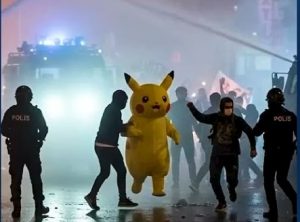If we follow the most recent political protests around the world through social media, we are likely to encounter Pikachu — a character from the Japanese anime Pokémon — running among protesters in Turkey, or thousands of South Koreans waving concert light sticks for idols as K-pop songs blast in the background during impeachment protests. Elsewhere, pro-democracy movements across Asia and the Pacific have coalesced under a now-familiar banner of the “Milk Tea Alliance.” At the heart of this symbolic repertoire are East Asian countries, which remain at the forefront of contemporary cultural production and soft power dissemination.
Whether these playful and symbolic acts hold revolutionary significance at first glance or not, people assign meanings to them. The light stick, once a simple concert accessory, has come to symbolize non-violence and collective spirit. Milk tea, too, has evolved into a signifier of regional solidarity and resistance. These symbols, memes, and icons are continually reappropriated to reflect the values, hopes, and frustrations of those taking to the streets.
How does this emerging strategy affect political mobilization and the broader cultural industry? Such cultural references function as powerful tools for amplifying the visibility and affective impact of protest. They may — and may not — carry inadvertent economic consequences. In South Korea, for instance, sales and rentals of concert light sticks have surged during protest periods, revealing how political mobilization can also stimulate consumer activity tied to pop culture industries. In contrast, the milk tea symbol operates differently: rather than generating new consumption, protests tap into the commodity’s pre-existing popularity.
The adoption of pop culture elements — especially those originating from East Asian countries, most notably Japan, South Korea, and China — has become increasingly prevalent in protest movements within and beyond Asia. This trend further solidifies these countries’ positions as global champions of the soft power agenda. Protesters have strategically drawn on East Asia’s popular culture to broaden the visibility and emotional resonance of their movements, thereby attaining a form of political legitimacy that speaks both locally and globally.
Take Pokémon, for example. With a legacy spanning more than two decades, the franchise remains deeply embedded in today’s global pop culture and stands as one of Japan’s highest-grossing media properties. It is telling that more people around the world are likely to recognize its most iconic character, Pikachu, than not — underscoring the vast global reach of Japan’s cultural exports. Even among those unfamiliar with the franchise, its viral circulation — such as during Turkey’s recent mass protests — extends its visibility and symbolic power, ultimately boosting the cultural economy that sustains it. And who hasn’t, at some point, tried Pokémon Go, a mobile phone game that became a worldwide sensation in 2016?
K-pop, too, has steadily evolved into a dominant force within global popular culture. Unsurprisingly, it has become embedded in recent protest movements. In Indonesia, for example, fans have mobilized not only during electoral campaigns but also in street demonstrations — waving K-pop light sticks and incorporating fandom aesthetics into protest performances. This reflects Indonesia’s position as one of the largest markets for K-pop in Asia.
The milk tea craze has been bubbling across Asia over the past decade, rooted in a shared cultural affinity for the beverage among several Asian countries. This everyday commodity has since been re-signified as a potent political symbol. Initially emerging as an anti-Beijing meme, milk tea has evolved into the emblem of a decentralized, youth-driven, and leaderless movement for democratic reform across Asia and the Pacific.
Grievances can be expressed in many ways, from tears to laughter. A sprinting Pikachu or a towering Godzilla — both perhaps on their way to becoming global protest memes — might now capture more attention than traditional protest forms, as their instant virality reveals. These images are witty, whimsical, and visually disarming, far removed from the stern, confrontational image of politics we’ve come to expect. But that is precisely the point, and their strength. They are captivating and unifying, particularly for those who are otherwise disengaged from political discourse. Their power lies in reach: sparking curiosity, generating conversation, and, at best, drawing in the disinterested.
One of the major challenges facing contemporary social movements is non-participation. This can stem from a variety of factors, ranging from tacit support for authoritarian leadership to pragmatic realities, such as economic hardship, family responsibilities, and the demands of daily survival. In other cases, it may reflect the perception of political mobilization as inherently dangerous, confrontational, or exclusionary. However, as the aesthetics of protest shift — from solemn marches to meme wars, flash mobs, and viral videos — so too do the emotional registers that make mobilization more accessible, less intimidating, and potentially more resonant with broader publics.
These strategies have been remarkably effective in animating popular mobilization. They go viral, offering a paradoxically “pleasant” viewing experience and an emotionally engaging alternative to traditional protest imagery, often marked by rage and despair.
This is not to suggest that serious and solemn forms of political contestation have lost their importance — nor does it diminish the gravity of the issues at stake. Rather, it highlights the rising significance of creative expression in protest: play and humor as tools to broaden appeal, sustain engagement, and reframe the emotional experience of political participation. These strategies help dismantle perceptions of protest as violent or threatening, making participation feel safer, even “joyful.”
Moreover, protest aesthetics are contagious. They are replicated, remixed, and localized across borders, inspiring movements that aspire to similar political outcomes. In the age of memes and hashtags, resistance travels quickly, becoming both an affective and aesthetic force.
Of course, not everyone needs to don a Japanese anime costume to make their presence felt. Yet, a single witty, scene-stealing figure amid a sea of demonstrators can become a spark — amplifying the protest’s message and giving it a viral afterlife. After all, in today’s movements, meme-making and hashtag wars are as integral as placards and chants.

































